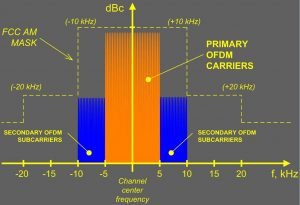
With the FCC’s call for comments on it’s rule-making to adopt rules allowing for voluntary all-digital operation of AM stations, I thought it time to reflect & offer some perspective on decisions facing AM operators as ‘AM Revitalization’ evolves to the next stage. I know there are at least one or two readers out there just itching to send me comments offering the opinions “Forget AM radio, it’s dead” or “Nobody listens to AM any more.” While some truth could be argued as to whether these opinions are fact, I refuse to believe AM is yet on it’s final days. The FCC is certainly to be applauded for proposing this radical move as VOLUNTARY rather than a forced change from analog to digital AM broadcasting as occurred with TV back in 2011. For once the feds are being sensible, proceeding with caution & seemingly willing to listen to all arguments both pro & con before implementing this into law. The FCC then set out a list of areas it wants to hear comments about. Regarding the predicted benefits of all-digital AM broadcasting, it asks dozens of questions about improved audio quality, auxiliary data, improved usable signal coverage, increased programming choices (such as music) and energy and spectrum efficiency. It also asked for comment on potential interference, including adjacent-channel, co-channel, digital-to-digital and nighttime interference. It further wants to know about the costs of conversion for AM licensees, the readiness of the public to transition to all-digital reception and the rule changes needed to implement the proposal.

Ad promoting all-digital AM broadcasting from Nova Scotia, Canada based company Nautel. The station displayed on the receiver is experimental all-digital 820 WWFD Frederick MD. Note also that Nautel is promoting it’s transmission equipment for the far superior HD codec – DRM (Digital Radio Mondiale) in addition to Xperi’s HD Radio.
Over the past month, I’ve made contact with a number of “indie” AM station owners, small broadcast ownership groups with AM facilities & a few stand-alone AM operations. My inquiries sought to gain some insight as to whether these operators are willing to make the leap to all-digital & also whether implementation of FM translators has improved their listening statistics, and more importantly, their bottom line. Call it a ‘barometer’ of the health & status of AM radio in small & medium markets. I made no effort to contact urban AM’s owned by corporate entities, but gained enough opinions from small & medium market operators to get a feel for the projected possibilities for city stations. Overwhelmingly, I was asked not to identify owners or call letters of stations I contacted as most indicated they wished to keep projected plans secret & under wraps, not wanting to reveal future moves to competitors. Suffice to say, I was in contact with AM stations here in Wash., also a few owners I’m acquainted with in Oregon, Utah & Alaska. Problems, solutions & issues discussed in previous blogs on AM once again came to the forefront in these dialogues.

Anatomy of an AM all-digital signal
When asked about the implementation of all-digital broadcasting, it appears there is little appetite among these stations, citing cost of equipment & required maintenance of all-digital transmission gear. Virtually all were primarily concerned with the loss of what listeners they do have, noting that the many with analog radios would be out of luck should these AM’s adopt all-digital broadcasting. Operators felt this was too risky given the somewhat short life-span AM radio may have left in it. Owners felt that in urban areas, going all-digital would be much more desirable for corporate owners or “indie” owners looking for an edge & specialized audience. Issues with interference to AM signals in large urban centers could make this attractive. Readers of our ‘AM Radio Today’ series will note this issue was discussed at length in one of our previous blogs. The proliferation of electronic devices, the onset of 5G wireless, power-line noise etc has greatly hampered reception of AM signals. Couple this with poorly designed AM circuitry in today’s motor vehicles & AM owners are clearly at a disadvantage. Will the costs associated with all-digital transmission & the loss of analog listeners be worth it to the competitive urban radio markets? Corporate AM stations in major markets already have one cost-effective means of transmitting a quality signal: use of an HD channel on co-owned FM stations. Here in the Seattle-Tacoma metro we have a number of our AMs already on FM HD channels – KJR-AM, KFNQ, KIRO-AM, KTTH, KKNW, KCIS & KIXI can all be received via FM stations. Bellingham`s KGMI is available on FM HD as well. Owners of newer vehicles can take advantage of these superior quality signals already, making the potential switch & implementation to an all-digital AM signal questionable for many broadcasters. However, it is one corporate owner that has been leading the way on all-digital. Hubbard Broadcasting is the owner of WWFD Frederick, MD that has been operating using this mode as a template for observations, technical evaluation & improvements plus the listening experience for digital & analog AM users. Hubbards’s AM stations in our market – KIXI & KKNW could potentially be among the first here to consider all-digital broadcasting. I’ll also hazard a guess that Andy Skotdahl’s KRKO & KKXA will also likely consider a change to all-digital AM. If such moves reduce the listening audience to these stations to their detriment, the fact the FCC proposed rule is specifying a voluntary adoption by broadcasters also means they can revert back to analog or analog-HD hybrid (IBOC). My perspective after feedback from small to medium market AM’s is that they will be watching results of city broadcasters closely before implementing any thoughts to investing in all-digital transmission. Corporate owned AM’s in these markets would likely be the first to try.

While the response on all-digital AM transmission as a solution to increasing listeners, ad revenue improvement & cost vs profit benefits seemed less than enthusiastic, the same small to medium market AM owners & management had a much different response to my second question – whether implementation of FM translators has created opportunities for these operators to improve their bottom line & gain new listeners. In the second part of this blog, I’ll reveal my findings on FM translators improving the health of AM broadcasters.

Some comments may be held for moderation. (New users)